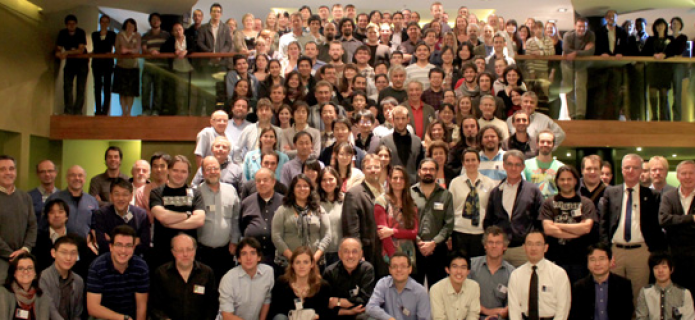Astronomers Around the World Meet to Share ALMA Observatory First Results
Astronomers from around the world have been meeting in Chile to discuss the exciting first year of scientific results from the Atacama Large Millimeter/submillimeter Array (ALMA) telescope. ALMA started Early Science operations at the end of September 2011, and the first scientific papers have recently been appearing in refereed journals.
"Out of this first year of ALMA science we already have transformational results in the main ALMA science areas," says Leonardo Testi, Chair of the Conference Scientific Organizing Committee. "We now have a much better understanding of the process of planet formation around other stars. New important results were obtained in the area of pre-biotic molecules in space, which may be linked to the origin of life. With ALMA we are starting to study in detail the chemistry of water and complex organic molecules and this is important for understanding our origins," he added.
Two-hundred astronomers from all around the world met from 12–15 December 2012 in Puerto Varas, a small, attractive resort town on the shore of Lake Llanquihue in Southern Chile, for The First Year of ALMA Science conference, sponsored by the ALMA partners ESO, NAOJ and NRAO, as well as the Joint ALMA Observatory, with additional support provided by CONICYT and by the EC-FP7 Radionet3 project.
The conference covered all the ALMA science topics: from observations of the Solar System bodies to objects in the Milky Way, in the local Universe and all the way out to the high redshift Universe. Presentations and discussions focused on the amazing data being collected with ALMA and included related theoretical implications and predictions as well as relevant complementary data from other major facilities.
For the first time ALMA offers the sensitivity necessary to study normal galaxies in the very distant Universe, far away in time, when the Universe was less than one billion years old (the age of the Universe is 13.7 billion years).
"We are proud of the first results obtained with the subset of ALMA that is already available," said the ALMA Director, Thijs de Graauw. "These results demonstrate clearly what ALMA will contribute to the understanding of the Universe when construction is completed at the end of 2013 and we have the full set of capabilities available for science. The discoveries discussed at this conference are already very impressive, but this is just the beginning of a new era of astronomy."
One result highlighted at the conference was the discovery of a simple sugar, glycolaldehyde, in a young analogue of the Solar System. This is not the same sugar as we use in our coffee — it is actually poisonous — but this molecule is one of the ingredients in the formation of RNA, one of the building blocks of life closely related to DNA.
"With ALMA we are also finding protoplanetary discs around brown dwarfs, which suggests that planet formation may be more common than we thought before," said Leonardo Testi.
Attendees at the conference also discussed the scientific priorities for the ALMA development programme, that will ensure ongoing upgrades of the observatory to keep it at the forefront of research into the Universe.
While many participating astronomers had some experience of the north of Chile where the main astronomical observatories such as ALMA are located, most had never been in the southern part of the country before. "They were delighted to discover the warm hospitality, exquisite cuisine and natural beauty of the region,"said Gautier Mathys, Chairman of the Local Organizing Committee.
ALMA, an international astronomy facility, is a partnership of Europe, North America and East Asia in cooperation with the Republic of Chile. ALMA construction and operations are led on behalf of Europe by the European Southern Observatory (ESO), on behalf of North America by the National Radio Astronomy Observatory (NRAO), and on behalf of East Asia by the National Astronomical Observatory of Japan (NAOJ). The Joint ALMA Observatory (JAO) provides the unified leadership and management of the construction, commissioning and operation of ALMA.
Links:
Contacts:
Valeria Foncea
Education and Public Outreach,
Joint ALMA Observatory
Santiago, Chile
Tel: +56 2 2467 6258
Cel: +56 9 7587 1963
Email: [email protected]
Douglas Pierce-Price
Public Information Officer, ESO
Garching bei München, Germany
Tel: +49 89 3200 6759
Email: [email protected]
Masaaki Hiramatsu
Education and Public Outreach Officer, NAOJ Chile
Observatory Tokio, Japón
Tel: +81 422 34 3630
E-mail: [email protected]
John Stoke
Assistant Director - Education & Public Outreach
National Radio Astronomy Observatory
Charlottesville VA, EE.UU.
Tel: +1 434 244 6896
Email: [email protected]
